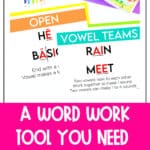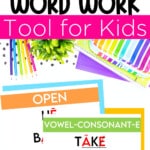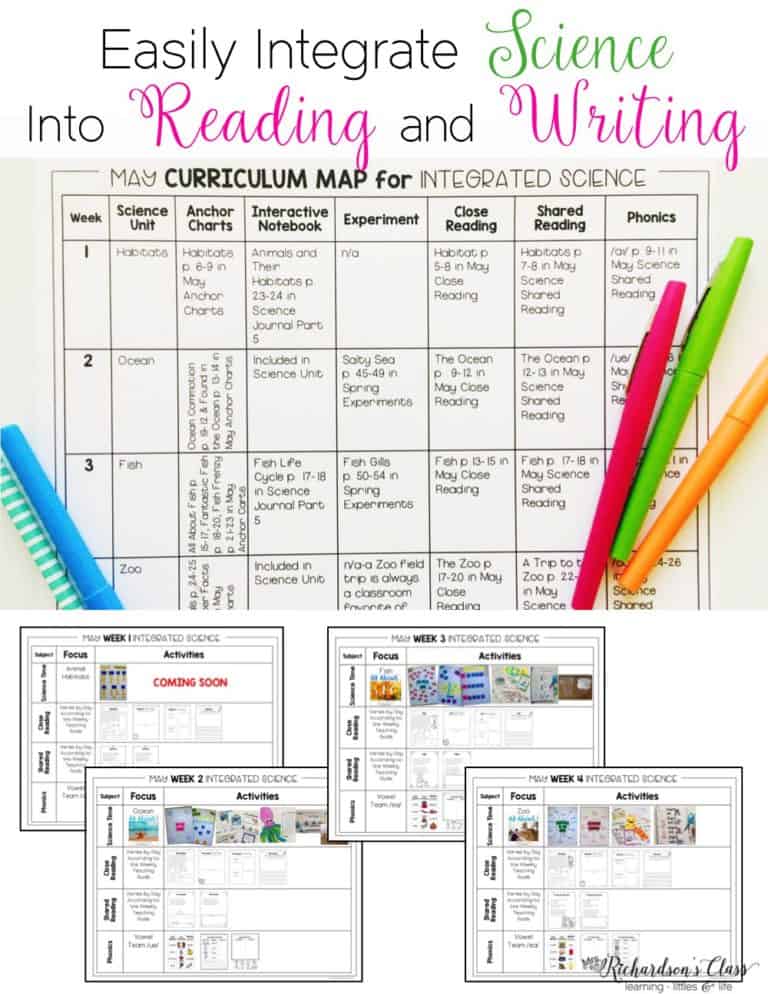


When it comes to work work, how prepared do you feel? I don’t know about you, but I felt like when my students and I had everything we needed for word work time (whether it was a whole group lesson, small group lesson, or literacy center), I was way less stressed. You’d probably feel the same! To help you feel like you are prepared and your students have a helpful resource, I wanted to share my favorite word work tool.
This word work tool can help your students throughout the day as they work on word work or phonics activities, in whole group lessons, in small groups where they are working on decoding skills, and during literacy centers. As kindergarten, first, and second-grade teachers, we all know that laying a strong foundation for language skills is crucial. So today, let’s dive into the Six Syllable Types Posters and why your primary classroom needs them! This is the tool that I WISH I had when I was first learning how to teach phonic
When it comes to teaching our students to read, we have to go back to the basics. I personally wasn’t taught phonics in an in-depth, systematic way, so I’m excited that we’re heading back to teaching students how to decode words. We want students to attend to the print when they are reading so that they actually decode words, not just guess at them.
When we teach our students the six types of syllables, we are equipping them with the skills to decode words with ease. Then as they grow in their reading skills, they will start seeing multisyllabic words. When our students know the six syllable types (along with vowel sounds), they can apply that knowledge to new, longer words
I want you to have my must-have word work tool to use in your classroom, too! Grab your FREE Six Syllable Types Posters to help you teach the syllable types and for your students to refer back to. Just enter your name and email address below, and I’ll send them right to you!
If you want to learn more about each type of syllable, I have a whole blog post on that. Click HERE to check it out!
One of my other favorite classroom tools for phonics word work is a sound wall. If you’re not so sure what a sound wall is or how to use one, I’ve got you!
A sound wall consists of words organized by speech sounds or phonemes. It shows the letters or letter patterns that represent speech sounds. Sound walls also usually have a picture of how your mouth looks when you say that sound. This helps students see what the sound looks like when they say it.
Most primary teachers break a sound wall up into two walls – a consonant wall and a vowel wall. Sound walls show the different ways we spell the different sounds. For example, the consonant k would have a word and a picture with the /k/ sound represented, but it would also have c shown as the /k/ sound with a word and picture.
It is best to build your sound wall as you introduce those phonemes in your phonics instruction. You want to build it with your students over time so they have ownership of it, too!
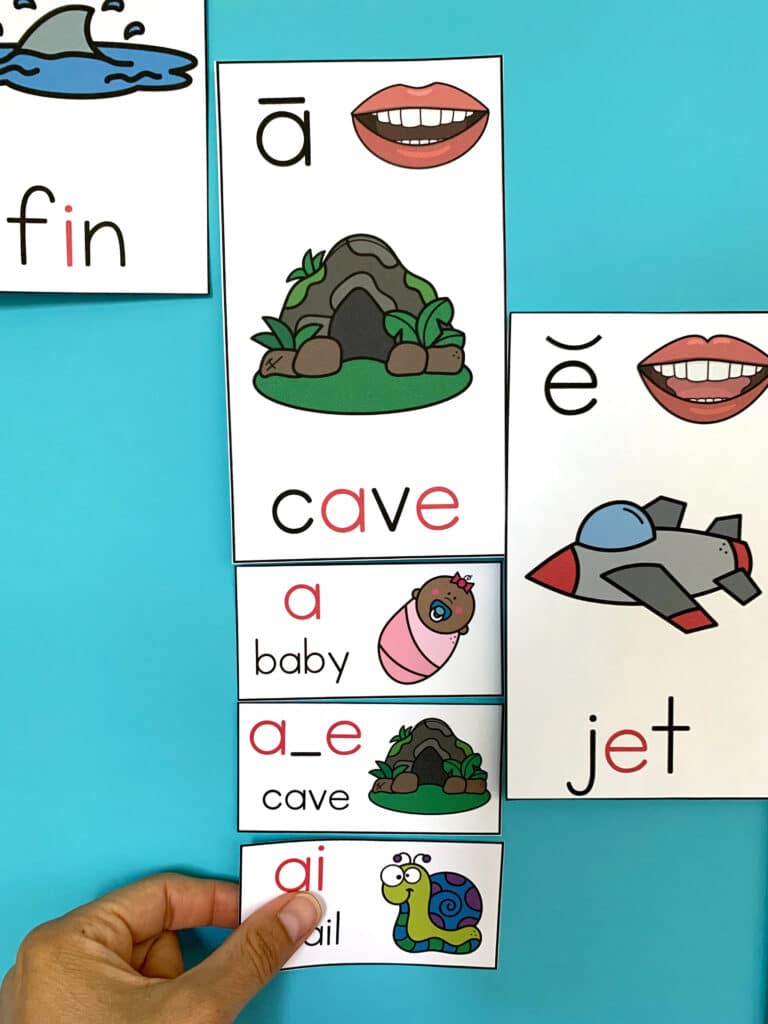
You may also want to include your high-frequency words where appropriate so students can learn to identify spelling patterns.
On a sound wall, you will sort the words by the sounds a word makes. If there is an irregular spelling of the vowels in the word, make sure you make that clear for your students.
I have a done-for-you Sound Wall you can grab to set up along with your syllable posters!
This is a great place to begin to add more science of reading research-based resources to your classroom! Not sure how to use one or set up a sound wall? I have blog posts to help you through it. Grab yours today to help your students build a solid reading foundation.

Want to use the latest research to boost your readers during small groups? This FREE guide is packed with engaging ideas to help them grow!

I’m a K-1 teacher who is passionate about making lessons your students love and that are easy to implement for teachers. Helping teachers like you navigate their way through their literacy block brings me great joy. I am a lifelong learner who loves staying on top of current literacy learning and practices. Here, you’ll find the tools you need to move your K-2 students forward!
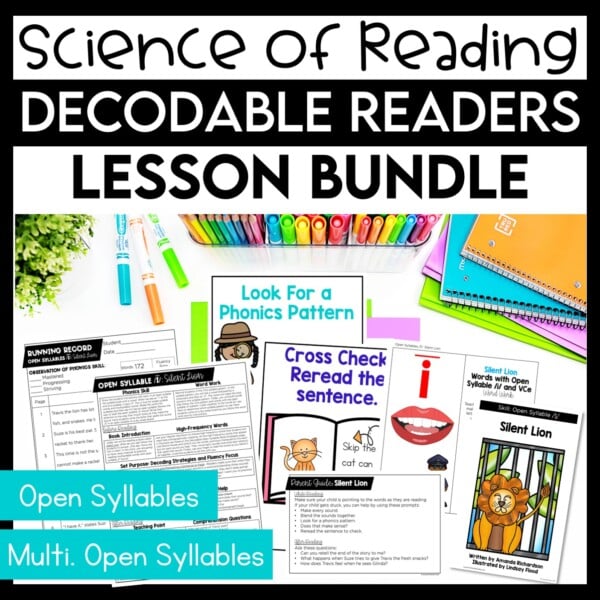


| Cookie | Duration | Description |
|---|---|---|
| cookielawinfo-checkbox-analytics | 11 months | This cookie is set by GDPR Cookie Consent plugin. The cookie is used to store the user consent for the cookies in the category "Analytics". |
| cookielawinfo-checkbox-functional | 11 months | The cookie is set by GDPR cookie consent to record the user consent for the cookies in the category "Functional". |
| cookielawinfo-checkbox-necessary | 11 months | This cookie is set by GDPR Cookie Consent plugin. The cookies is used to store the user consent for the cookies in the category "Necessary". |
| cookielawinfo-checkbox-others | 11 months | This cookie is set by GDPR Cookie Consent plugin. The cookie is used to store the user consent for the cookies in the category "Other. |
| cookielawinfo-checkbox-performance | 11 months | This cookie is set by GDPR Cookie Consent plugin. The cookie is used to store the user consent for the cookies in the category "Performance". |
| viewed_cookie_policy | 11 months | The cookie is set by the GDPR Cookie Consent plugin and is used to store whether or not user has consented to the use of cookies. It does not store any personal data. |
